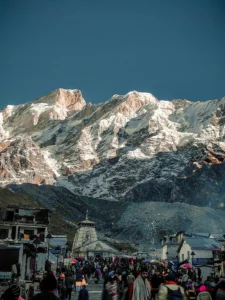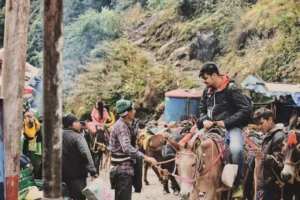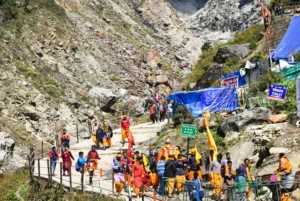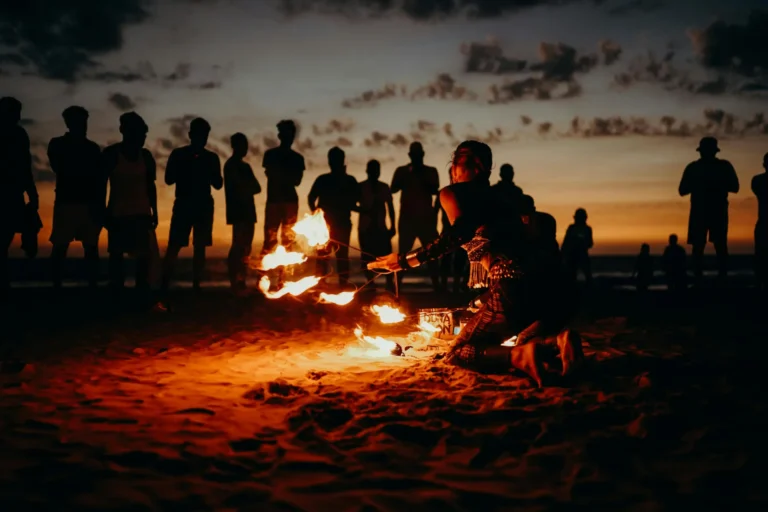No matter how many photos you’ve seen or stories you’ve heard, nothing really prepares you for Kedarnath. It’s not just a trek, or a temple visit. It’s something else. Somewhere between the panting breaths and the freezing winds, you get this feeling like the mountain knows you’re there.
I started from Haridwar, took a bumpy ride up to Sonprayag. Roads were winding, a little scary at times, but the views man, they were something else. Reached Gaurikund by a shared jeep. That’s the base camp, if you will. After that, it’s just you, your legs, and a whole lot of uphill.
Most people don’t talk about how emotional this trek can be. You see old people, kids, folks who clearly aren’t regular hikers, just trudging forward. Why? Faith. It’s all faith. That’s the fuel here. And tea. There are these little stalls every few kilometers selling chai and Maggi, and somehow that instant noodle tastes better at 10,000 feet.

How to reach Kedarnath temple?
Through halfway, you might feel your legs go a little numb, but your mind gets sharper. The air will get thinner, which might feel a little uncomfortable and every breath might feel like it’s earned. That’s when you know you’re close. Somewhere around 12 km in, you will catch your first glimpse of the holy place of Kedarnath valley. It will be a surreal moment. You will stop, stare, take in the moment all that hardship through the trek will feel worth it. There’s the majestic temple in the distance, tucked right under the watchful eyes of the Himalayas.
No photo can do it justice to the place. That tiny silhouette of Kedarnath Temple, surrounded by snowy peaks, feels more like a painting, like a dream come true rather than the reality itself. Even with the hum of the crowd, it’s like the mountains mute everything else. There is rush and noise but somehow it feels music due to the place you will be in.
Once you reach the top, there’s a checkpoint. Your ID gets checked, and then finally you walk into the mighty Kedarnath Temple complex. Stone walls, blackened by time and weather. Nandi Ji’s statue out front And that energy you feel it. Something old, something sacred you know the aura of something great and divine yet timeless. It’s not polished or flashy. Just solid, timeless, and utterly powerful.
Darshan isn’t rushed and shouldn’t be rushed. Even with the line, it moves at a pace that lets you take it in the moment, the beauty. The hills make the weather perfect. The priests inside will barely speak. Just gestures, blessings, tilak on your forehead, and you’re out. No grand ceremony maybe because you can feel the greatness, and weirdly, you walk out feeling lighter.
I sat outside for hours, wrapped in my shawl, sipping chai from a tin cup. I just stared at the temple as the clouds rolled in. I knew no pictures will ever do justice to this place or this moment I was living in. There’s peace in that silence. You don’t even have to pray. Just being there is enough for you. It’s everything you have ever dreamt about and more.
And if you’re not up for trekking the whole way, and the idea of it sounds tiresome, you’ve got options. You can:
Hire a pony: Costs more, but gets you up there faster.
Take a palanquin: Carried by four guys. More common for older devotees.
Helicopter ride: From Phata or Guptkashi. Quick and scenic, but you miss the walk. And trust me, the walk is the pilgrimage.

Table of Contents
ToggleWhen to trek for Kedarnath?
Timing matters, big time. Best time to visit is from Late May to mid-June, and again from September to early October. Monsoons in July and August turn the trail into a muddy mess, and frankly, it gets dangerous with landslides. Due to this reason it is not advisable to Visit the temple in the monsoon Winter? Don’t even think about it unless you want to be best friends with hypothermia. The temple shuts down from November till April anyway.
Things to pack for Kedarnath trek
Packing? Please Don’t overdo it, but don’t be underprepared either. A good pair of walking shoes is non-negotiable. And please don’t get your normal sports shoes. You need Proper trekking shoes and they should be waterproof if possible. Carry a raincoat even if the skies look clear and is too Sunny. The weather changes in a few minutes there.
Clothes? Take layers. T-shirt, hoodie, windcheater. Gloves if you get cold easily. A small towel, toilet paper, pain relief spray (you’ll thank me later), power bank, and a basic first aid kit especially if you’re prone to altitude sickness or knee pain.
Food? Please stick to simple stuff on the way. Maggi, tea, biscuits, maybe a paratha if your stomach’s brave. Avoid heavy meals; it slows you down. Keep hydrating yourself as if your life depends on it. You won’t feel thirsty in the cold, but your body’s working overtime.

Travel cost for Kedarnath
Now let’s talk about money. If you’re doing it on a tight budget, trains, shared jeeps, basic guesthouses, and food you can wrap up the whole trip at ₹6,000 to ₹9,000 per person. Add ponies or a helicopter and the cost shoots up ₹2,500 to ₹7,000 one-way for the chopper depending on season and service.
Accommodation at the top? Basic but clean. GMVN rest houses are decent. You might have to share. Carry your own bed sheet if you’re picky. Book early, especially during peak season.
But here’s the truth: you don’t come to Kedarnath for comfort. You come for something deeper. You come to disconnect, and weirdly, reconnect. With yourself. With something ancient. Something you can’t quite name but you feel in your bones when you stand in front of that temple.

Travel tips for Kedarnath
What they don’t tell you about Kedarnath is that the trek stays with you long after your feet stop hurting.
There was this moment on the way down, just past Rambara, I think where I stopped to drink water and realized how quiet it was. No cars. No phones ringing. Just the wind moving through pine trees and a distant murmur of the Mandakini river. That silence, It was different. view Kedarnath on google map.
I saw a man sitting cross-legged, eyes closed, head slightly tilted toward the sun. I didn’t disturb him. I just watched. For all I know, he could’ve been praying or just resting. But he looked completely at peace. And for the first time in a long while, I felt that too. No rush. No deadlines. Just breath and earth and sky.
I think that’s what this whole trip does: it strips everything back. No filters. No distractions. You start off thinking it’s about getting to the temple, but somewhere along the way, you realize it’s about meeting yourself.
So if you ever feel lost, tired, or just fed up with the noise of life, go. Walk that path. Let the mountain teach you what stillness really means.


